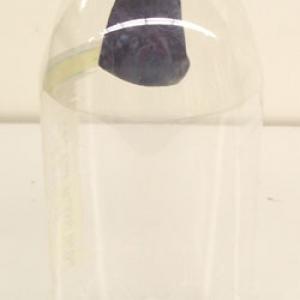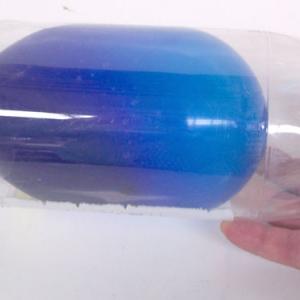College of Liberal Arts & Sciences
2B30.49 - Balloon in a Bottle - Air or Water
See also 10A05.10 in Chemistry and Physics of Everyday Experience
Insert the balloon into the bottle and stretch the opening of the balloon over the mouth of the bottle as shown. If you put your finger over the hole in the bottom of the bottle you will not be able to blow up the balloon. Remove your finger and you can blow up the balloon to fill the inside of the bottle. Put your finger over the hole when the balloon is blown up inside the bottle and balloon will remain inflated.
You may also do the above experiment using water. Blow up the balloon in the bottle and hold it in the expanded state by putting your finger over the hole in the bottle. Fill that expanded balloon with water. When you remove your finger from the hole in the bottle, the water will shoot out as the balloon deflates.
- Josip Slisko, "Two Demonstrations of Atmospheric Pressure Designed by Students", TPT, Vol. 60, #6, Sept. 2022, p. 514.
- Sebastian J. Spicker, Alexander Kupper, Andre Bresges, "Mission to Mars - Concept and Implementation of a Design-Based (Hands-On) Smartphone Experiment Helping Students Understand the Effects Caused by Differences in Air Pressure", TPT, Vol. 60, #1, Jan. 2022, p. 47.
- Gholamreza Shamsipour, "Simple Experiments for Teaching Air Pressure", TPT, Vol. 44, #9, Dec. 2006, p. 576.
- Martin Gardner, "The Jumping Pencil", TPT, Vol. 37, #3, Mar. 1999, p. 178.
- Charles Vivian, "Air Presses in all Directions", Science Experiments & Amusements For Children, p. 68.
- Martin Gardner, "The Mysterious Balloon", Science Tricks, p. 20.
- Martin Gardner, "13, Suspended Water", Smart Science Tricks, p. 25.
- Martin Gardner, "40, The Jumping Pencil", Smart Science Tricks, p. 64.
- Bobby Mercer, "The Impossible-to-Blow-Up Balloon" Junk Drawer Chemistry, 2016, p. 24.
- Bobby Mercer, "The Impossible-to-Deflate Balloon" Junk Drawer Chemistry, 2016, p. 27.
Disclaimer: These demonstrations are provided only for illustrative use by persons affiliated with The University of Iowa and only under the direction of a trained instructor or physicist. The University of Iowa is not responsible for demonstrations performed by those using their own equipment or who choose to use this reference material for their own purpose. The demonstrations included here are within the public domain and can be found in materials contained in libraries, bookstores, and through electronic sources. Performing all or any portion of any of these demonstrations, with or without revisions not depicted here entails inherent risks. These risks include, without limitation, bodily injury (and possibly death), including risks to health that may be temporary or permanent and that may exacerbate a pre-existing medical condition; and property loss or damage. Anyone performing any part of these demonstrations, even with revisions, knowingly and voluntarily assumes all risks associated with them.

